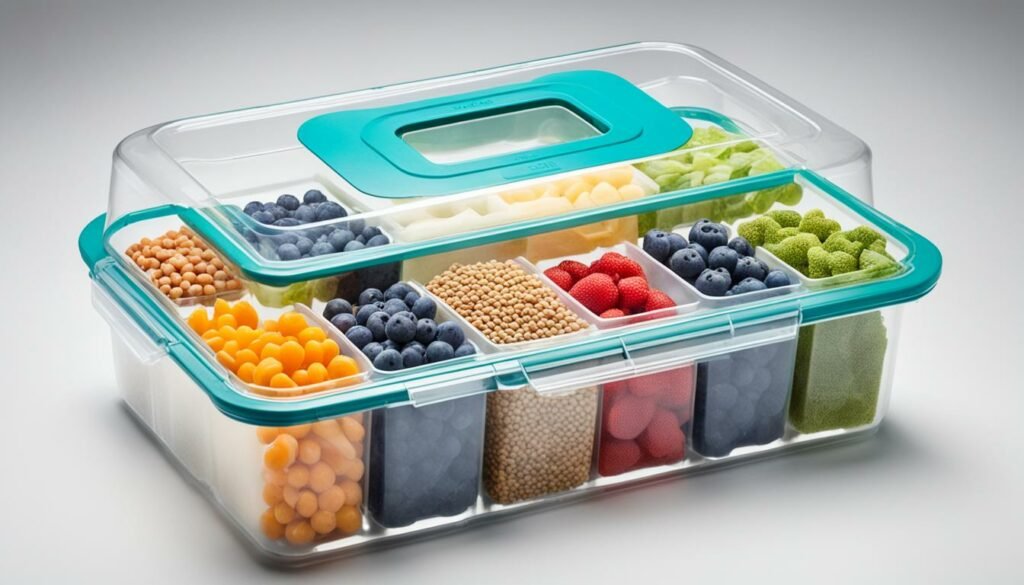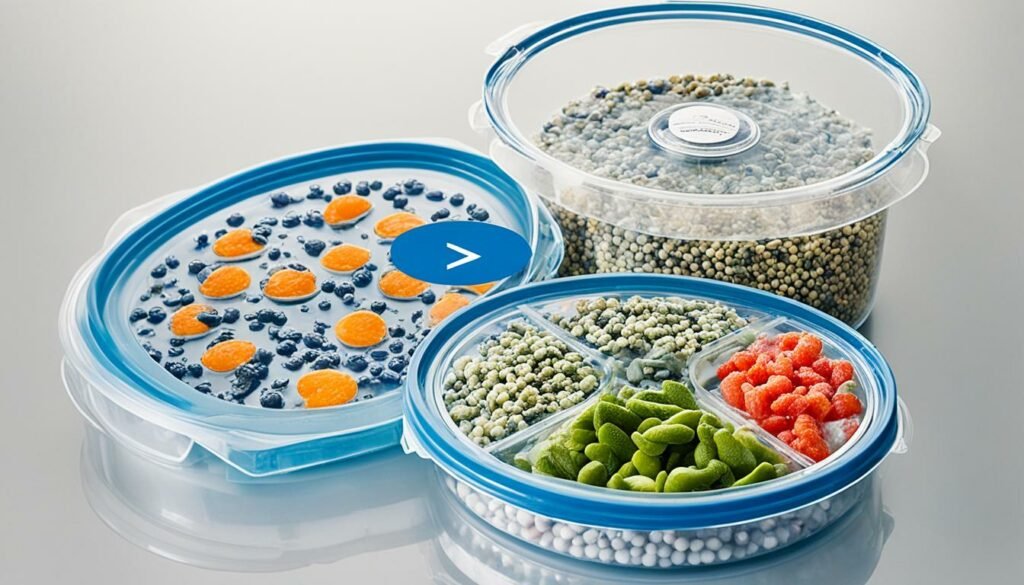Have you ever wondered what keeps some foods fresh for so long? The answer lies in small packets hidden in your food storage. These are oxygen absorbers, key in keeping food fresh.

We throw away 1.3 billion tons of food each year. Oxygen absorbers change the game by making food last much longer. They turn your pantry into a smart, long-term storage solution.
Oxygen absorbers lower oxygen in closed containers to just 0.01%. This stops most bacteria that spoil food. It keeps your food fresh like it's in a time capsule.
They work best with dry foods like cereals and nuts. These items have little moisture and they benefit the most. But remember, don't use them with moist foods.
Now, more than ever, people want fresh food without preservatives. Oxygen absorbers are now built into food packages. This changes how we keep and ship food. Studies suggest they can make food last over two weeks longer.
Are you curious to know more about oxygen absorbers? Let's see how these small packets can change your food storage game.
Understanding Oxygen Absorbers: What They Are and How They Work
Oxygen absorbers are key for keeping food safe and fresh. They are packets filled with iron powder that soak up oxygen from food containers. This keeps the food last longer, reducing the chances of spoiling. I will tell you about their parts, how they work, and the different types available.
Composition of Oxygen Absorbers
Oxygen absorbers are made of iron powder and salt at their core. Some types also have other things to help them work better. The iron powder pulls in the oxygen. Then the salt helps speed up the reaction.
The Science Behind Oxygen Absorption
A special reaction makes oxygen absorbers do their job. The iron powder mixes with the air's moisture and turns into iron oxide. This takes the oxygen out of the package. Without oxygen, bacteria and mold can't grow, keeping food fresh longer.
Types of Commercially Available Oxygen Absorbers
There are different kinds of oxygen absorbers for varying uses shown below:
| Type | Composition | Best Use |
|---|---|---|
| Iron-based sachets | Iron powder, salt | Dry foods, nuts, seeds |
| Ascorbic acid-based | Vitamin C, catalysts | Moisture-sensitive foods |
| Polymer films | Photosensitizing dyes | Liquid products, beverages |
Knowing about these types helps you pick the best one for keeping your food fresh. This makes sure your food stays safe and tastes good.
The Importance of Oxygen Control in Food Preservation

Oxygen control is key in keeping food fresh for a long time. It stops food from turning bad over time. This is big for keeping food good in cases of emergency.
Limiting oxygen stops fats from going bad, keeps meat looking fresh, and helps baked goods stay smelling good. It also keeps vitamins and flavors strong in drinks like coffee and tea. Plus, it blocks bacteria and fungi that make food spoil.
Research shows how good oxygen control is. Using iron-based methods can make food last 14 days instead of just 3-4. Iron powder films can remove 33 cm³ of oxygen per square meter in 4 days.
| Oxygen Control Method | Benefit | Application |
|---|---|---|
| Iron-based scavengers | Increase shelf life to 14+ days | General food preservation |
| Enzyme-based systems | Prevent nutrient loss | Nutritional preservation |
| Oxygen absorbers in pouches | Minimize experimental trials | Packaging optimization |
The market for inorganic oxygen removers will keep growing until 2026. This shows how vital oxygen control is. It affects both businesses and homes when it comes to storing food well.
Key Benefits of Oxygen Absorbers for Food Preservation
Oxygen absorbers are key in keeping food fresh. They have many benefits for preserving food. Let's dive into why they are so important.
Extended Shelf Life
Oxygen absorbers can make food last a lot longer. They take oxygen out of the package. This slows down how quickly food goes bad. With them, I've seen food stay fresh for over ten years.
Preservation of Flavor and Nutritional Value
These absorbers keep food from spoiling easily. The food keeps its flavor and nutrition much better. So, the food still tastes good and is healthy to eat, even after a while.
Prevention of Microbial Growth
They help keep food safe by stopping bacteria and mold. By taking out the oxygen, these absorbers create a place where it's hard for microorganisms to grow. This means less chance of getting sick from food.
Cost-Effective Solution
Oxygen absorbers are a smart, affordable way to preserve food. They are not costly and can be found easily. Using them saves money by reducing food waste and how much you spend on new food.
| Benefit | Impact |
|---|---|
| Extended Shelf Life | Up to 10+ years for properly stored foods |
| Freshness Preservation | Maintains original flavor and nutritional value |
| Microbial Control | Prevents growth of aerobic bacteria and mold |
| Cost-Effectiveness | Reduces food waste and packaging costs |
In summary, oxygen absorbers do a lot to keep food safe and fresh. They help food last longer, keep its taste and nutrients, and reduce the risk of getting sick. And they do all this in an affordable way, for homes and businesses.
Optimal Usage of Oxygen Absorbers in Food Packaging
Learning to use oxygen absorbers well is vital for keeping food fresh. Choosing the best container makes sure your food stays preserved. Foil pouches, metal cans, PETE bottles, mason jars, and Mylar bags are great for storing food with oxygen absorbers. They keep an airtight, ideal environment for storage.
Choosing the Right Container
I stay away from plastic ziptop bags and thin plastic containers. They let too much air in. Instead, I pick strong, airtight ones. They're perfect for storing food long-term and for emergencies.
Proper Sealing Techniques
Sealing the containers properly is super important. I seal them right away after putting in the oxygen absorbers. With freeze-dried foods, adding a vacuum seal to the oxygen absorbers is the best way. It creates the perfect spot for keeping food fresh for a long time.
Calculating the Correct Amount of Oxygen Absorbers
Figuring out how many oxygen absorbers you need matters a lot. I use this simple rule: Residual Air Volume = Container Volume – Food Volume. In a quart jar, one 50cc absorber is normally enough. Bigger containers or those with more air might need more. Knowing the right amount helps keep your pantry and food well-organized.
FAQ
What are oxygen absorbers, and how do they work for food preservation?
Oxygen absorbers are tiny packs that have iron powder and salt. They suck up wetness and air. This turns the iron into rust, dropping the air inside to almost none. This stops food from spoiling by blocking the growth of some bad bacteria. This makes food last longer and stay fresh.
What are the benefits of using oxygen absorbers for food preservation?
Oxygen absorbers do a lot of good things. They make food last years longer if you keep them well. Food tastes and keeps its nutrients better because they stop air from changing the food. They also keep out bacteria and mold, making food safer. Plus, they're not expensive and good for the earth.
What types of foods are suitable for using oxygen absorbers?
Best to use oxygen absorbers with foods that are dry or low in water and oil. Don't use them with foods that have lots of water. This helps avoid a serious illness called botulism.
How can I ensure optimal usage of oxygen absorbers in food packaging?
For the best results, pick the right sealed container. Metal cans, foil bags, or Mylar bags work well. Seal them right. Use the right amount of oxygen absorbers for the container and food. Check they work by feeling if they're warm and seeing if they change from pink to blue.
Are oxygen absorbers safe for use with food?
Yes, oxygen absorbers are safe for keeping food fresh. They are made without harmful chemicals like BPA. They are a mix of iron powder and salt.
